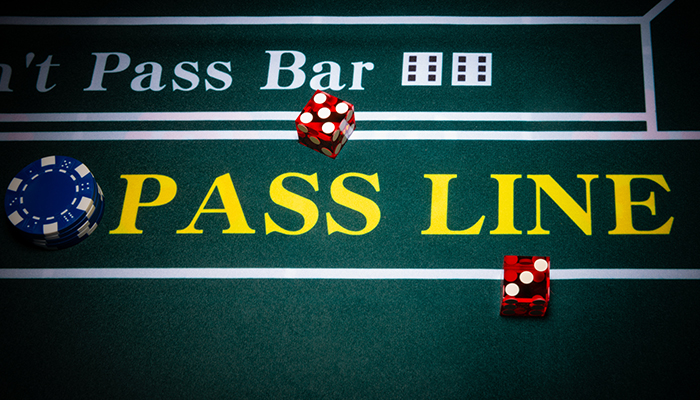Explained: Basic Craps Rules
 Basic Craps Rules
Basic Craps Rules
Many people are intimidated by the Craps table in that it is often perceived as having a large number of rules and that it has many different payoffs. But in reality, the rules are straightforward, as we will show you, and you can trust your dealer or the online casino to get your payoffs right until you have a better understanding of the game.
The other craps table rules that can leave new players feeling intimidated are those unspoken rules at brick-and-mortar casinos that are enforced not by the casino itself but by those incredibly superstitious players around the game. These small superstitions have grown into unwritten rules over the years, but we will explain them for you so you aren’t stared down for some perceived faux pas.
- 🎲 Craps Rules for Shooting the Dice
- 🎲 Craps Games Rules Concerning the Point
- 🎲 Craps Games Rules Concerning the Bets
- 🎲 Unwritten Craps Dice Rules
- 🎲 Conclusion
Craps Rule for Shooting the Dice
Let’s start out with some craps rule pertaining to shooting the dice as casino personnel can be a little fussy about these. Each player on the dice will be given the opportunity to shoot the dice. The person throwing the dice is the shooter. The dice pass from person to person clockwise from the box person. You will normally need to already be at the game and preferably already wagering before you will be given the dice. This is to prevent people from constantly squeezing into the next spot to shoot just to become the shooter.
The shooter must make a pass line or don’t pass bet. You will see the pass line like a ribbon all around the outside of the game. Place your bet there. Pick two dice. You may pick up the dice with one hand only. No switching hands. If you do need to switch, set the dice back down, then pick them up with your other hand. Do not take them any further than the rail; they need to be in full view all the time.
Keeping the Stick Person Happy
Don’t school the dice, meaning toss them around or against the wall you are standing in front of. Any forward motion will probably constitute a roll, and it holds up the game. Just pick them up and toss them all the way past the box person to the back wall. Both dice should hit the opposite wall every time to ensure a fair roll.
There is a proper height for the dice to be thrown at, which is several inches above the layout at a bare minimum to no higher than the eyes of the stick person. It should never appear that you are just sliding the dice down the layout, nor should the stickman ever have to look up away from his layout to follow the dice.
This probably already sounds like a lot, but as the roll determines the random event at the heart of the game, the house needs to ensure that it is indeed random and that nothing happens with those dice, such as being switched out.
Craps Game Rules Concerning the Point
If the shooter rolls a seven or eleven, the pass line wins, and they shoot again. If they roll a two, three, or twelve, they lose their bet, but not their turn. They may shoot again until they hit a point. Once a number other than seven, eleven, two, three, or twelve is rolled, that becomes the point.
The shooter needs to roll that number again before a seven to win. If they hit it again, they win their pass-line bet and will roll again to establish a new point. If they roll a seven, all of the bets are cleared, and the dice move to a new shooter.
Should the shooter choose to bet on the don’t pass, they will lose on seven or eleven. They will win on a two or three and push on a twelve. Anything else becomes the point, but now they must roll a seven before they hit that number again.
Craps Games Rules Concerning the Bets
While you can bet the pass line at any time, it only pays even money, so in reality, you should never bet it except on the come-out roll, either yours or another shooters. You may not bet on the don’t pass after a point is established.
The come and don’t come bets are essentially pass or don’t pass bets you can make after a point is established, so you may not make them until we have a point. Think of them as secondary bets; we can’t make them until the primary bet is established. Another craps dice rule is that these bets will be off on come-out rolls unless called working.
Field and Center Bets on the Dice Table
Craps games rules allow us to bet the field at any time as you can any of the prop bets. The prop bets are bets like Any Craps, which pays you if two, three, or twelve rolls. Or a Horn, which adds an eleven to the Any Craps bet; you can even bet on Any Sevens, which is rather self-explanatory. In most games, you can bet on exactly how the next roll will come, say a four and a two. All these bets are one-roll bets; either you win or lose on the next roll.
However, the hard way bets, also found in the center of the table, are not one-roll bets. For instance, if you bet the hard four, you are betting that that number will come as a pair, also called the hard way. Instead of just the next roll, the bet stays until a seven, OR the dice roll four, but not the hard way. This means you lose that bet not only on a seven but also if the dice roll a three and a one.
Place and Buy Bets
Place best allows you to pick numbers four, five, six, eight, nine, or ten. Bets on these wins if the number rolls, and they stay up until seven rolls. They are generally off on the come-out roll until a point is established, but you can instruct the dealer to turn them on if you wish. You can bet on them anytime, but remember, without explicit instructions, they remain off on the come-out. The four and ten pay nine to five, the five and nine pay seven to five, and the six and eight pay seven for every six.
Buy bets allow you to bet on those same numbers, but now you will be paid true odds. You can buy a bet anytime, but since they are off on the come-out, it is best to wait until a point is established. Buy bets are generally made for $20 and up because the house will charge you a 5% vig on the bet, so it wouldn’t make much sense for the gambler to bet it for less.
Some casinos will consider this a rule and won’t let you buy a number for less than $20. Others will not allow you to buy the five and nine, and since it makes little sense to buy the six and eight, you may find a casino where you can only buy the four and ten. Most casinos will charge you the 5% vig before it hits, though some only charge when you get paid.
Mathematically, games where you only pay the vig after you hit are far preferable. The four and ten get paid two to one on buy bets, and where you are allowed to buy them, the five and nine get paid three to two.
You can also lay bets, which means you are now betting that a seven will roll before the number you laid against rolls. The trick here is that you only get paid one for every two you bet on the four and ten and only two for every three on the five and nine, and you still need to pay the 5% vig, which means that you need to bet at least $41 to win $20 if you lay against the four or ten.
Taking Odd on the Pass and Come
Odds bets are very much like buying a bet, except we have the extremely unusual ability to place these bets without paying a vig. This means that we get true odds against the house on these bets, meaning that the house has a zero percent advantage. That doesn’t happen often.
Odds are taken on either pass or come bets. How much you can place will depend on the casino; most online craps games are 2x odds though you can sometimes find 3x. Brick and Mortar casinos can run from 2x all the way up to 10x. For many years, Binion’s Horseshoe in downtown Las Vegas would have a special in December where you could get 100x odds.
Again, these bets pay two to one on the four and ten, three to two on the five and nine, and six to five on the six and eight. When you are betting the don’t pass and or don’t come, you are allowed to play odds in the same fashion, with every two getting one on the four and ten, every 3 getting two on the five and nine, and every six getting five on the six and eight. You will need to establish your point, or the come or don’t come have moved to a number before you can take odds.
Unwritten Craps Dice Rules
Some other rules that you may encounter at the dice game that may or may not be enforced are more etiquette-based. Many casinos don’t allow any pictures or filming at their dice games. In fact, they won’t even allow your phone to be out.
One is because neither the dealers nor the other players have given consent to be filmed and probably don’t wish to be. Second, nothing is as aggravating as someone on their phone trying to talk over the stickman and the dealer who are simply trying to deal with the game. Have some common sense, take your phone calls away from the game, and don’t be filming people who don’t want to be on your TikTok feed. It will save you legal trouble later.
Nothing in the Rail
No drinks, sunglasses, purses, or phones are allowed in the chip rail. These items often get knocked down and interfere with the roll of the dice, or in the case of a Daiquiri or Pina Colada, will leave a sticky mess on the layout that causes the dice game to be closed. If you’ve never faced the wrath of an entire dice table because you didn’t know where to put your drink, and now they got to go play blackjack, I’d argue you don’t want to.
Dice players like a good strong drink when they play, and this is expected, but when you’ve perhaps overindulged, you quickly become a liability. Dice is a fast-paced game; the casinos make their money off each roll and expect to keep those dice moving.
When you start dropping chips on the layout, taking too long to make your bets, or worse, becoming argumentative with staff or other players, the casino will quickly see you off because there is so much money on dice games that they don’t have time for someone even slightly tipsy to delay the game or take the chance that person might spill a drink or worse onto the table.
Working Area
The come area in the center of the table is where we place buy-ins and color-ups. First, ensure the dice are in the middle of the table, then put your cash into the come area. The dealer will give it to the Boxman, who will count it and tell the dealer how much to give you. He will push your chips to you. When it is time to color up, it’s the same.
Make sure the dice are in the middle, then place your chips in the come while informing the dealer that you are coloring up. They will pass those chips to the box person, who will run them down and get a total. They ask if you agree, and then you will be given larger denomination chips that are easier to carry. Don’t place your color up on the layout directly in front of you. The dice tables are large, and they will struggle to reach it.
Unspoken Craps Table Rules and Etiquette
As previously mentioned, dice players are a cantankerous and curmudgeonly crowd. This, combined with several hundred years of serious superstition around the game, means that there are some unspoken craps table rules that we need to go over. While none of these will get you in trouble with the casino, they certainly will get you shouts of disapproval or worse from your fellow dice players.
Don’t Buy-In in the Middle of a Roll
The casino wants you to buy in as soon as you get there because they want to start making money off you right away, but watch closely. The old-time players don’t buy in until a new point or the come-out roll. Many times, they will wait for a seven out before buying. This is because nobody, and I mean nobody, wants cash hitting the layout in the middle of a roll. You will be greeted with a chorus of turn my bets off and boos.
Everybody knows that is bad luck. They could just bet the Any Seven and say thank you for causing a seven out if they were really convinced that a seven was imminent, but they’re superstitious, not crazy.
Hands Up, Dice Out
Anything that changes the proper roll of the dice should be avoided. The worst of these is putting your hands down to make a bet after the stick man says no more bets. Common courtesy tells you the shooter needs room to shoot the dice without hitting you, but if you ignore this and one of the dice strikes you, there will be problems.
Similarly, if you throw in a late bet on the layout and the dice strikes it, expect loud and constant complaints from your fellow players. Even stacking your odds bet too high on the end where the dice are landing may get you negative feedback if the dice strike them and they seven out.
Big Red
And lastly, never ever say seven on a dice table. You might as well smash a mirror while holding a black cat while walking under a ladder. It’s that bad. Heck, it’s worse cause you’ve not only jinxed yourself but the whole table.Potential replacement words include Skinny or Big Red,, as in give me the Big Red for $5, meaning give me the Any Seven for $5. However, using seven while there is a point established is considered not only bad luck but disrespectful.
Conclusion
We’ve covered most of the basic craps rules here. It probably seems like a lot, but the dealers will help you with any of the craps game rules that concern the house, and you can rest assured that the other players will let you know about any craps tables rules of etiquette.
Don’t forget; if you are just learning to play, online craps games can help you understand the rules of craps and how the bets work long before you touch your first set of bones, which is an everyday slang for those dice.




